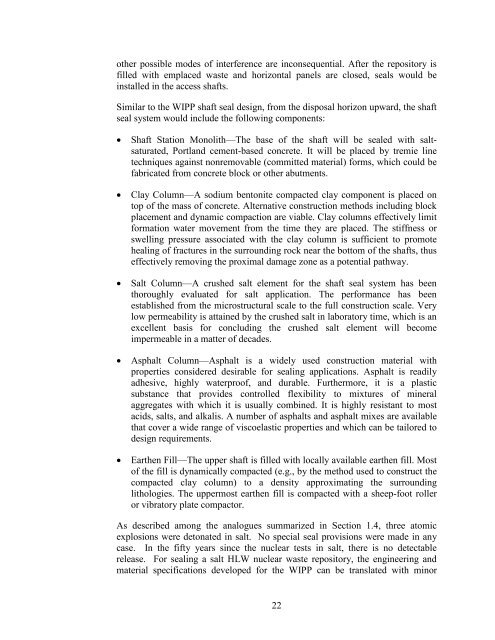Salt Disposal of Heat-Generating Nuclear Waste
Salt Disposal of Heat-Generating Nuclear Waste
Salt Disposal of Heat-Generating Nuclear Waste
You also want an ePaper? Increase the reach of your titles
YUMPU automatically turns print PDFs into web optimized ePapers that Google loves.
other possible modes <strong>of</strong> interference are inconsequential. After the repository is<br />
filled with emplaced waste and horizontal panels are closed, seals would be<br />
installed in the access shafts.<br />
Similar to the WIPP shaft seal design, from the disposal horizon upward, the shaft<br />
seal system would include the following components:<br />
• Shaft Station Monolith—The base <strong>of</strong> the shaft will be sealed with saltsaturated,<br />
Portland cement-based concrete. It will be placed by tremie line<br />
techniques against nonremovable (committed material) forms, which could be<br />
fabricated from concrete block or other abutments.<br />
• Clay Column—A sodium bentonite compacted clay component is placed on<br />
top <strong>of</strong> the mass <strong>of</strong> concrete. Alternative construction methods including block<br />
placement and dynamic compaction are viable. Clay columns effectively limit<br />
formation water movement from the time they are placed. The stiffness or<br />
swelling pressure associated with the clay column is sufficient to promote<br />
healing <strong>of</strong> fractures in the surrounding rock near the bottom <strong>of</strong> the shafts, thus<br />
effectively removing the proximal damage zone as a potential pathway.<br />
• <strong>Salt</strong> Column—A crushed salt element for the shaft seal system has been<br />
thoroughly evaluated for salt application. The performance has been<br />
established from the microstructural scale to the full construction scale. Very<br />
low permeability is attained by the crushed salt in laboratory time, which is an<br />
excellent basis for concluding the crushed salt element will become<br />
impermeable in a matter <strong>of</strong> decades.<br />
• Asphalt Column—Asphalt is a widely used construction material with<br />
properties considered desirable for sealing applications. Asphalt is readily<br />
adhesive, highly waterpro<strong>of</strong>, and durable. Furthermore, it is a plastic<br />
substance that provides controlled flexibility to mixtures <strong>of</strong> mineral<br />
aggregates with which it is usually combined. It is highly resistant to most<br />
acids, salts, and alkalis. A number <strong>of</strong> asphalts and asphalt mixes are available<br />
that cover a wide range <strong>of</strong> viscoelastic properties and which can be tailored to<br />
design requirements.<br />
• Earthen Fill—The upper shaft is filled with locally available earthen fill. Most<br />
<strong>of</strong> the fill is dynamically compacted (e.g., by the method used to construct the<br />
compacted clay column) to a density approximating the surrounding<br />
lithologies. The uppermost earthen fill is compacted with a sheep-foot roller<br />
or vibratory plate compactor.<br />
As described among the analogues summarized in Section 1.4, three atomic<br />
explosions were detonated in salt. No special seal provisions were made in any<br />
case. In the fifty years since the nuclear tests in salt, there is no detectable<br />
release. For sealing a salt HLW nuclear waste repository, the engineering and<br />
material specifications developed for the WIPP can be translated with minor<br />
22
















